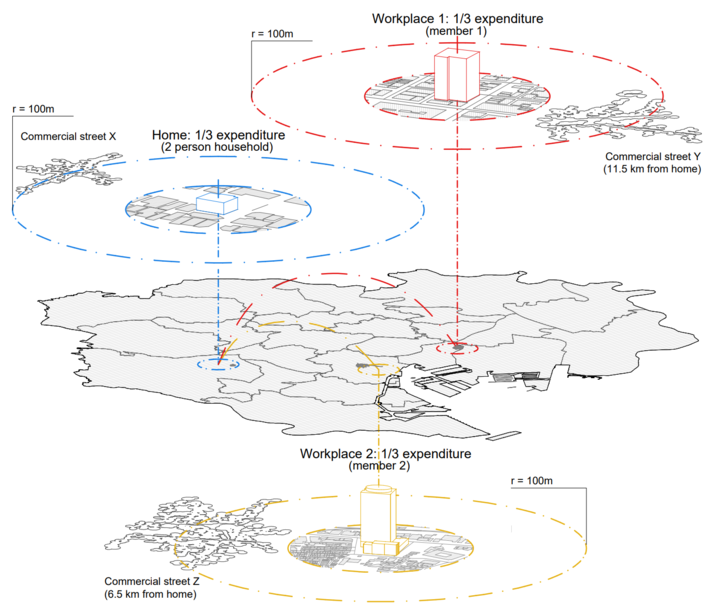
本研究では、通勤活動を導入した擬似人流データを用いて、店舗の立地モデルの信頼性を向上させることを目的とします。東京都内347の商店街における非住宅主導型需要をモデル化することを目的として、起点-終点フローを用いて、世帯の潜在的な支出を自宅と通勤場所に分配します。その結果、家計の潜在的支出を昼間の場所に再配分することで、従来のハフモデルのパフォーマンスが大幅に向上し、ベースラインモデルと比較すると決定係数が54%増加する結果を得ました。更に、歩行者の軌跡カウントを使用することで、ハフモデルの枠組みで距離を使用するのと同等になり、決定係数が57%増加することが明らかになりました。一方で、商圏を画定するために使用した軌跡モデルと従来のハフモデルの組み合わせは、決定係数を59%増加させる場合に最も優れた性能を示しました。本研究は、実際の客出しのデータが利用できない場合に小売分析において擬似人流シミュレーションを使用する可能性を示しています。
In this research, we use synthetic human mobility data, which introduces commuting dynamics to improve the reliability of retail location models. We use the origin-destination flows to distribute households’ potential expenditures in their home and commuting locations with the aim of modeling non-residential-driven demand in 347 commercial streets in Tokyo. We found that redistributing the potential expenditures toward the households’ daytime locations significantly increased the traditional Huff model’s performance, with a 54% increase of the coefficient of determination over the baseline model. Additionally, we found that our use of pedestrian trajectory counts is comparable to using distance within the Huff model framework, where we obtained a 57% increase of the coefficient of determination. Nevertheless, a combination of the trajectory model, used to delineate trade areas, and the conventional Huff model had the best performance with a 59% increase of the coefficient of determination. This study demonstrates the potential of using synthetic human mobility simulations for retail analysis in when real customer-outlet data is not available.
【論文情報】
S. Garcia-Gabilondo, Y. Shibuya, Y. Sekimoto, Enhancing geospatial retail analysis by integrating synthetic human mobility simulations. Computers, Environment and Urban Systems, 108 (2024) 102058.
https://doi.org/10.1016/j.compenvurbsys.2023.102058
